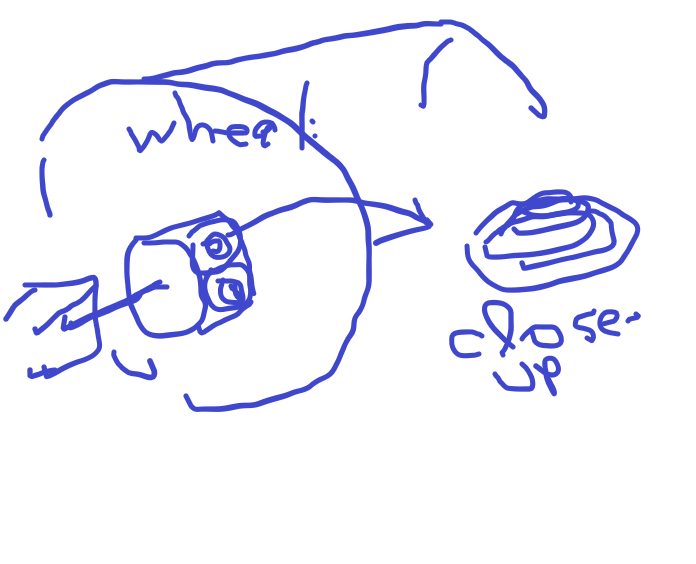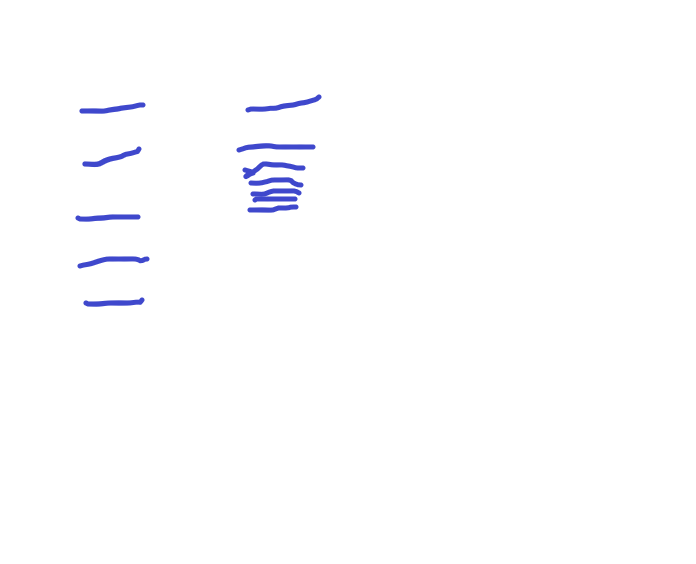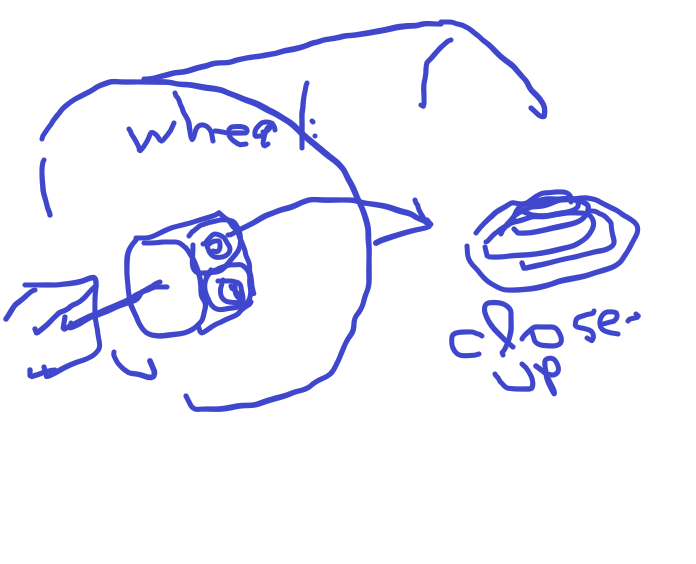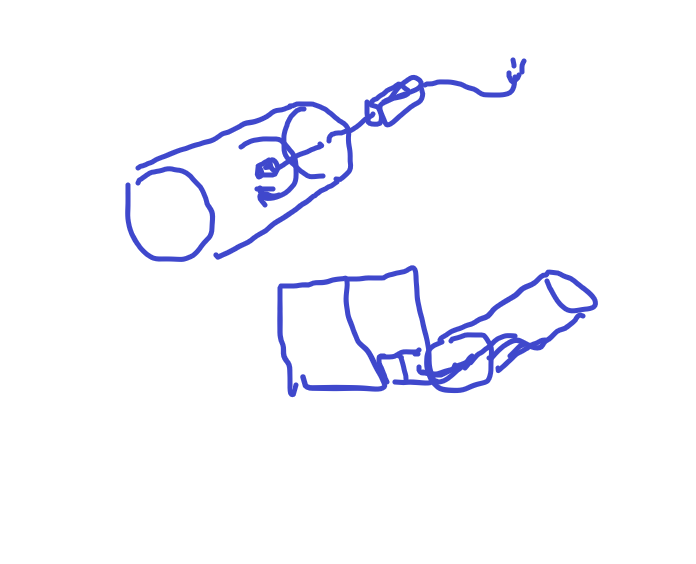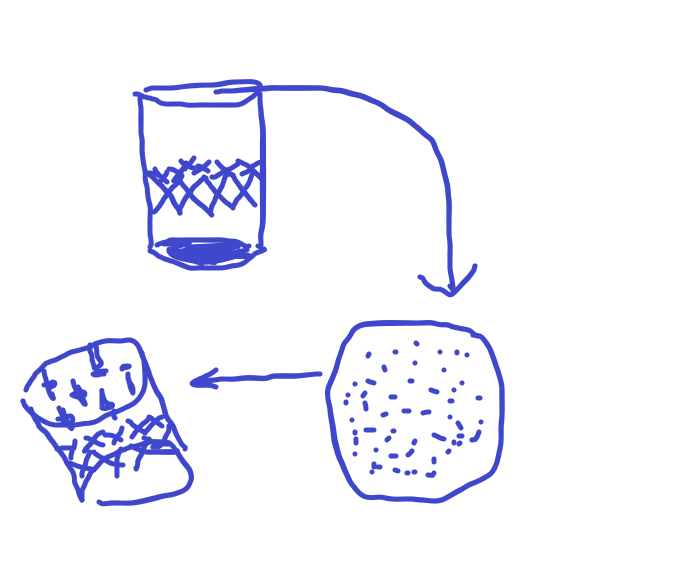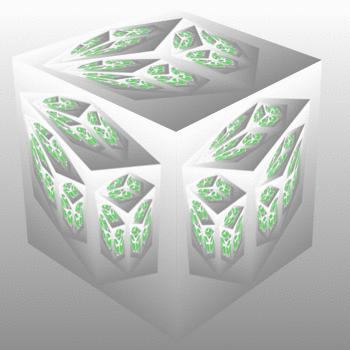-
Posts
77 -
Joined
-
Last visited
Content Type
Profiles
Forums
Events
Everything posted by t686
-
Well my current idea is that it may be possible to use a telescope to make, say, 100 stars, move like a wave. At the smallest level, light can act like a wave, so at larger scales, 100 stars should be capable of moving in a wave. If it can, that means that superluminal motion is possible.
-
It didn't just wave in front, but had a definite blow towards, and stayed sucked on the tube's entrance. I think the picture shows the outward tube, with a much smaller solid spinning cylinder or wheel (with shallow mountains on the surface. The wheel of RedBaron's device is connected by a fixed rod to the electric motor that's a box closest to the viewer in blue lines.
-
The picture (my drawing with blue lines) shows a tube that houses a spinning "wheel" driven by an electric motor. On the wheel's surface are shallow mountains, as the close-up shows. RedBarron's experiment a year ago was to show that driving a wheel to high speed draws a normal flat sheet of paper to the tube's entrance. RedBarron's device is similar but not identical to a tesla turbine: A tesla turbine's set of washers with air between each washer, air flowing into the chamber drags the washers, and centrifugal force forces air away from the disc, which gets balanced by a spiralling vortex inward at high speed, and exactly when the outward centrifugal force balances the spiralling vortex, is there a drop in sound and the turbine sounds a tuned sound. The mountains on the surface of RedBarron's device, splits air, creating the spiralling vortex, but it's missing the air being forced out or lost from the core as in the tesla turbine, since RedBarron's core is smooth, air will not be lost out of the core. However, he did train a camera on the experiment, and all digital cameras contain a lossy form of image compression. It was the lossy image compression in real time that provided the air being forced out or lost from the core. The experiment shows that something not expected can affect an experiment, even something that doesn't normally touch part of the experiment, the camera. The paper would not have been blown towards RedBarron's device and stay stuck unless it became tuned like the tesla turbine.
-
You can fight bacteria with moldy water. I use it myself as a lid under an aquarium that grows moldy with water down there, and syringe it into the dirted tank. The bacteria was making me sick until I added mold, and it has to cycle like a regular aquarium, adding it daily until it grows on the gravel and dirt and then you don't have to add it any more. What also controls bacteria is minerals and you can collect that during a rain where water flows over something rocky or concrete but best if it's like a concrete culvert that's homemade going over grass like a run where the water above is flowing over grass and pinestraw at the top of the hill and then flows over your culvert. I'm trying to see if the moldy water will clear the mineral water because it's darker like iced tea, but doesn't smell bad due to the minerals.
-
I was thinking about the abrupt change in lakes, where you have a distinct cold layer at a certain depth in the summer time. I thought what would happen if you mix the the water, but have a flat spinner that spins in the plane that separates the cold and hot water (and not spinning as to randomly mix the cold and hot layers in weird folds the other direction). Centrifigual force would separate the cold and hot, because the hot would move further out in the spinning plane, and then the cold layer would form a bubble that would float up to the surface. In an efficient circuit, the heat surrounding the circuit, there should be a cold layer right next to the surface (if they haven't found it yet). I wonder if spinning a computer circuit, in the flat plane like spinning a record, that in this example, heat would be driven away from the circuit, by centrifugal force, and thus you could keep increasing the speed of computation. The idea is that a spinning circuit may compress random data, not just with the heat idea, but perhaps it is separating something in the data, this is an idea, that repeated compression that normally shows no improvement, spinning the circuit would at some point allow the data to be compressed. This is not unheard of in experiments, as in making Aerogel, the best insulator, or in making metallic glass, there is a shaking of the autoclave. But it would appear that they could make a much thinner and more efficient aerogel if the autoclave were very flat, and they spun it at the supercritical stage in the same flat plane like a record, to separate the two phases so aerogel would come out not brittle and be thinner. I assume that this would actually work if the computation were done not in RAM but on a hard drive, that is, to alter the programming of the compression algorithm to run totally in the hard drive. The spinning hard drive would impart an efficiency that should allow compression of random data, which hasn't been done before.
-
You can see on the website, https://quantumfrontiers.com/, scrolling down the page, it mentions tiling the plane aperiodically. If you can tile it correctly, you can make a turing machine out of it. What I was noticing that when they make aerogel, the least dense commercial prouct, they put the gel into an autoclave, and the pressure combines a liquid and gas into one. I was previously thinking that you need two things to make something interesting, when really it's just about the one thing. It's a little bit complicated, but I made an X-shaped cellular automata, you can hit play on the first post in this thread: http://www.conwaylife.com/forums/viewtopic.php?f=11&t=3195&start=0 However, you see it's a solid square shape mass of white and black squares followed by 4 long diagonals. It's the center part that's important. I made a clockwise and flipping over that pattern, you have then a counterclockwise pattern. However, splitting that center large square mass (remove diagonals), and joining the clockwise top half to a counterclockwise bottom half, makes a single tile that tiles the plane. By rotating the tile 90 degrees or flipping it, you have essentially a different looking tile but it's the same tile, and they would join on the triangles edge to edge. There 's a spacing in between the tiles, but like in the quantumfrontiers.net, if you lay out a row of the tiles, at some point there should only be one choice on how to add the next row. This is a pattern for a cellular automata, but that's what it would be. Also, http://mathworld.wolfram.com/SingularPoint.html, the reason why I decided to now update the center part is, look at the "ordinary double point" in that link. Originally I made the pattern with a single tile with 4 long diagonals extending out from it. They were originally clockwise or counterclockwise. When you make the clockwise, for instance, the four long diagonals each curl in the clockwise direction. By changing the center large mass of the X pattern, to clockwise on the upper half of the center mass, and then changing the bottom half of that center mass by only flipping the bottom half left-to-right, so you have a center tile of clockwise over counterclockwise in one. That clockwise upper half, in the "ordinary double point" in the wolfram link, the upper two lines curve clockwise, and the lower two lines curve counterclockwise, same as in my new center tile (which I haven't posted or drawn but will show it later as an update). You're joining the tiles connecting them edge to edge left-to right at the triangles, and then start another row, like in the turing machine tiling in quantumfrontiers.net. The original tile actually spins in a circle at the center in the cellular automata. Now the worlfram singular point, the new tile is like that, and notice the picture of the double point is basically "bound" on one half, and "diverges on the other half. That's the same as joining jpeg compression with fractal compression. On compressing a jpeg movie, the edges of the image are jagged or square and choppy, which causes ghost images in the lossy compression to fan out to a great distance from the image as ghostly remnants. The fractal image compression leaves smooth edges, so it "bounds" any ghost images, the jpeg, "diverges" them. I believe the tiling of the original center mass, you're removing the long diagonals, so you have an actual tiling on a cellular automata square grid in 2-dimensions. That's a chaotic rule I used, and I'm not sure, but it may be that you make the cellular automata in a tiling like this, hit play, and since this rule looks like snow on a television screen, it may just be that you use the tiling as "background noise" pasted behind your image, so that the image will compress random images in a lossless form of the best compression method today, because random images or data cannot currently be compressed, if you tile the background with chaotic noise in a single image tiling aperiodically, it replicates a supercritical thing like when they make aerogel, so it would be able to compress random data. Actually the original center mass, works by itself (the center area on the pattern, without the long diagonals, it then makes a square tile). Flipping it left-to-rgiht, makes a mirror image of the original but doesn't change the tile. You would use the mirror image and the original image somehow (in some combination in the entire pattern) in tiling them in a long row left to right, joined at the "flags", and then start another row. The reason the original image spins at the center is that rotating the original center piece through 90 degrees changes nothing about the appearance of the image at all, because it's invariant to 90 degree rotations, but you need the mirror image to make a tiling (flip left-to right or flip up-down, doesn't matter to make the mirror image)
-
I was wondering if you could selectively combine the normal jpeg compression with fractal compression. To make a metallic glass, I thought it was the fractal part of glass that made it unique, but actually it's combining a solid and a liquid into one. I believe this has something to do with the sudden change in temperature in water at a certain depth. I believe that when combining two things, that it creates a unique area of "very low disorder", because when you bounce a metallic glass ball, it continues to bounce, so that little is lost to random vibration, that is, when bouncing, the low disorder aspect of it comes through to maintain an almost perfect bounce back. Notice there is no mention of fractal there, it's just two different things. Jpeg compression leaves wide pixel gaps along the edge or choppy edges, whereas fractal image compression creates smooth straight lines of images. I wonder if there is some way to combine the two to leave a low disorder result, because those are very different image compression methods.
-
I would say chlorine salt and chlorine are identical in that both act as balling up things. What I'm saying is that balling up a fractal is what you want to do. A metallic glass is fractal, but it's not ideal in that it can shatter and is not tough. I wonder if adding chlorine gas in addition to the argon which is added in a vacuum to make the metallic glass (and to rapidly cool it), would make a better metal. I don't want to say that you can grow a flawless diamond or other gemstone at home, but perhaps a suitable balling up (antifractal) agent in addition to just adding some algae water to whatever used to grow or make the mineral would make somebody able to do it. What I got from the pressure cooked algae water is that you took a fractal, cooked it under pressure that may be what it is, not necessarilly "burnt" particles, that it's the pressure that made the pot temperature invert the surrounding sink water used to cool the pressure cooker in a deep sink filled with water to cool the pot. So to purify water to make it drinkable that is after adding chlorine and letting it gas off, the water treatment or yourself could pressure the water in a pressure chamber or compressing it with a hydraulic press, (because the water already has small fractal things floating in it that the chlorine didn't get). But it might need a chemical like what chlorine does that makes the water drinkable as water that is gassed off, it has a "plastic" taste that has nothing to do with the container that stores the water, there is no antifractal to make it drinkable now.
-
I noticed that tap water is smooth to drink, but I don't like the chlorine aspect of it, although chlorine makes it smooth to drink. I believe there is an atomic substitute that would be good to replace chlorine once the chlorine treats the bacteria, it can evaporate and the new molecule substitues. You can see how chlorine salt affects soil, it makes the soil larger balls, and decreases the surface area, so it's an antifractal, chlorine is https://www.sciencedirect.com/science/article/pii/S0038080616300099. If gas pollution is an irritant, then burning woods or charcoal paradoxically can improve the air quality if it's not too much, because it's a coarse particle in the air, so burning something that is molecular, a gas, to decrease pollution may work, and in the absence of any gasoline pollution, you would need some particulate burning or the burning or release of the molecular substitute smoke to inhibit bacteria in the air as bacteria will burn the lungs, it's better to have an antifractal inhibitor. I believe that Goodenough's new glass battery which he probably hasn't perfected is based on a GOOD fractal but a not optimized yet antifractal that inhibits fractal explosiveness or overabundance of fractal in his battery design, as it has the potential to make a better battery by combining the fractal and antifractal. Personally, I found growing algae adding to tap water that sits out, it burns the mouth, but making a tea by pressure boiling the algae water, and adding a small amount of that in additon to adding a small amount of the algae water that is not boiled to the tap water that has sat out, adds small burnt particles (the antifractal as a course material, but best to have a molecular material instead but not found yet) to inhibit the bacteria from burning the mouth, although it's not as good as chlorine, it doesn't have the bad parts of chlorine either and it may mellow out over time, the water that is. Just to show the fractal nature of bacteria, the pressure boiler pot used to cook the algae water, when the pot is immersed in a sink filled with water so you can open the pot, it is cold an inch away from the pot, and very hot away, like the termperature inversion in water in a lake, the fractal nature of the algae does it, but I wonder if it's also due to the burnt nature that is inverting the scheme.
-
I was wondering if one could change the aspect ratio, ie the length to width of a stove's entrance from 1 for a square to a length to width of the square root of 3, so you can cap off the chimney in an efficient stove like a rocket stove? The only question I have is that in looking at interpolation and decimation in image analysis, you can make an image appear fuzzy from close up, by say, cutting the square out with a few more smaller squares to make the edge more ridged in the stove opening. My idea is based on a cellular automata, two dimensional, each square has a length of 1 by 1 but the diagonal is the square root of 2. Apparant motion that the eye sees of collection motion of squares moving diagonally must travel faster than other directions, in particular left-right and up-down, because the diagonal is longer, so I presumed widening the stove entrance in that manner would slow down diagonal vortical motion of air to decrease small rotations and turbulence that would interfere and cause biased rotations to prevent a natural tornado that would spawn in that manner to cause the stove to always suck air into the stove. My question is, does this seem too simple, and is there perhaps an image analysis that is lacking, such as making the edge some ridged manner to more strongly distort things back to the proper air stillness to spawn a tornado? Does anybody know of any good image distortion techniques that would do something similar? For all I know you would need a cross of both root 3 rectangles as an opening. For all I know you would need a computer to control the fuzzy squares opening and closing and a neural net to actively sense the air, but opening and closing a few squares is not energy costly.
-
I'm going to try this, but I think this will work with my cellular automata. The one I made on Conway Life Forum, under "other cellular automata", it's a post titled quantum computer, and in it, is an X shaped pattern in an explosive or expanding rule, so this matches the Sierpinski fractal (or fractal explosion). There's one pattern with the X, where I extended these horizontal lines, so when the pattern expands, it looks like two of those mounds in RedBarron's spinner. But you can copy and paste a single line horizontally right at the center (there's actually two centers since the center originally was four lit squares), so pick the bottom one and copy the line all the way across the pattern from left edge to right edge. You can then find the 1-dimensional cellular automata (the X is 2d) that is the Sierpinski fractal and use this very long line. Then wrap the edges but a shift of 1 square on the top edge relative to the bottom, so it's torus wrapping but a shift of one. Then I'll have to program or use a fractal video compression to record it in a video. The shift before always created a line that shot across the screen almost instantly in the blinking squares. But if you zoom out and alternate the wrapping from a torus to a torus of shift of one square, ie alternate the type of wrapping between a plain torus and a shift of square top to bottom like in pac-man, a line will constantly be shooting across the screen. But the edge is going to be like RedBarron's device, it's going to suck pixels into the line, like a cloud, so the line should start to gyrate and wiggle like a worm, and I believe it could be used as an intelligence, and the reason it would work is that in any video recording there's shared errors that create ghostly pixels on the edge, but since these all align, the explosive rule in 2d, taking a long line into a 1d sierpinski fractal, and recording with fractal image, it should show up. It's the clockwise X pattern in the first post on that forum, and notice 4 "flags" on the 4 edges of the large square that stick out, ie the flags stick out from the large center area on the horizontal and vertical edges of the large center thing, there are 4 small flag looking things that I have on it. Well you can draw a line from a flag on the left edge of the center large square out all the way to the length of one of the 4 diagonal arms, but then keep drawing again by that same distance, and do the same, draw a line from the right flag. When it executes, you have a bowed out thing going out beyond the 4 arms, and instead of a spinner at the center, it's now a see-saw. I let it expand until the top and bottom dark V's, it makes a general X shape the whole thing but you want to still have some of the black V, so a general X-shape, and then copy and paste a single long horizontal line after that pattern expands for a while. A 1-d cellular automata grows out in a V-shape from a single line of light and dark squares at the start, but I'm thinking to wrap the copied line to keep it a single line (the copied line from the ---2d---- automata and into a 1d automata that's the 1d sierpinski generator), ie it's just a blinking single line, but alternating the type of edge wrapping every so often, so that when you zoom out the straight line appears to bend and move from the sucking effect of Red Barron device (here it's shared errors and ordered dithering in the edge pixels of fractal video compression, a lossy form of video compression) that should collectively the outside ghostly pixels to make it appear upon zooming out in Golly, that the line is snaking through a cloud endowed with its own intelligence.
- 7 replies
-
-1
-
By the way this also might be used for fractal image compression, which is no longer used due to slowness of encoding vs. jpeg. If you are looking at images that are compressed with fractal encoding, or perhaps groups of pictures, you would wants to place the pictures in the fractal image compression instead of a simple same-size subdivision of equal squares say each square holding 20 pixels, you would want to alter the algoriithm for fractal image compression so that you subdivide the picture in a fractal way (instead of just subdividing the image like a chess board, and then collect the 8 aiffine transformations for comparision between image and range for reduction of distortion, which is the end result of the fractal image compression, you go for the same end result, the reduction of distortion (collage theorem) but subidivide the image in a fractal way of varying sized blocks of your picture) to create "connections" that are more durable or more linked that then could be translated into a neural net algorithm for better learning. Because small connections would then blow up to a definite connection in this way in fractal image compression.
-
I think that since RedBarron's device criss-crosses the air inside the tube (from the X-shaped indentation between each mound from the spinning metal wheel inside his much larger metal tube, that's open in the front, closed in the back), what normally is outside would stay outside, ie air outside wouldn't get caught up in that criss-crossing inside. But spinning it in an acceleration: The picture on the left shows waves generated from constant spinning wheel, the one on the right shows in time the waves generated from accelerated, they get closer and closer together, and since the velocity of the one behind is faster, the one behind will actually overtake the one in front, so the same thing, if you connect batteries in parallel but use a much longer wire, you could connect two groups with a shorter wire, this is what I'm thinking, in a fractal connection, so you can have much fewer batteries generating the same power in a car's electric bank of lithium ion batteries. And so RedBarron's device, outside the open front, the oscillation from the spinner inside can generate a noticeable draft because it balloons up small drafts to larger drafts that then go inside the criss-crossing of air inside, whereas before it couldn't go inside at all in a cosntantly spinning velocity, but an accelerating spinner generates the energy from fractal spacing of its waves. ie the sierpinski triangle fractal, it keeps getting divided by a constant number, so it would look like the picture on the right. RedBarron's spinning wheel, showing the back of the tube that's sealed in the back. Inside the tube is a small spinning wheel or small solid cylinder really that has "same sized mounds or mountanis" with valleys in-between, the valleys look like shallow X's since the mounds are actually very shallow: The close-up on the right is a blow-up of a single mound that is on the surface of his spinning wheel, that was dremelled out to create the shape of the mounds. And what's on the far left is the electric motor that has a rod connected to the spinning wheel with same-sized mounds, probably 8 or 9 of them in a row around the circumferance of the spinning wheel.
-
The idea is that a fractal connection would generate a much longer wire, but between two groups of fractal connections, you could have a short wire connecting them to mimic an overtaking wave from RedBaron's air waves generated and travelling towards the inner surface of the tube, during acceleration, waves are being overtaken.
-
The RedBarron "gravity generator" generated an air suction into a tube closed in the back and open in the front, with a spinning small cylinder that was driven in an accelerating or decelerating rotation by an electric engine, the spinning small metal cylinder that spins connected by a rod to the electric motor in the back of the sealed back tube. The shape of the small spinning metal cylinder were very shallow same sized mounds of equal size in a single row around the circumferance of the spinning small cylinder. The spinning small cylinder drove the air or impacted the air at an extremely high accelerating or decelerating rpm. The mounds being shallow are aerodynamic and you can imagine that between same-sized mounds, a shallow X indentation between mounds, so air is really criss-crossed from a stable aerodynamic row of the mounds on the spinning small metal cylinder that cuts through the air. And it was acceleration that caused it (or deceleration), and not a constant speed of the rpm and I'll explain what happens. The idea is it generates a fractal. The spinning cylinder impacts the air inside the tube and a wave travels toward the surface of the outer tube and bounces back. But since the driven spinning small cylinder (or wheel as he calls it) is accelerating, the waves that are generated are generated closer and closer in time. So looking at the spacing, it's exponential, so it's like dividing by two on every step, so it generates the Sierpinski triangle fractal. Now suppose you look at air outside the tube. The criss-crossing of the air from the aerodynamic mounds on the spinning cylinder might make you think it's possible to generate a fan that could possibly suck air into the back if the mounds were curved like a propeller but they're not shaped like a propeller. I haven't figured out the exact mechanism but I think that since it generates a fractal, air outside the tube, ----------------a small draft outside the tube can suddenly grow to a large draft---------------------- that gets caught up in the criss crossing of the air INSIDE the tube. And why does the draft outside suddenly grow, because not only does an accelerating spinning cylinder generate waves in time that get closer and closer, since the one behind is is travelling faster, it can catch up and overtake the one in front, so you're making easier a process that wouldn't happen any other way, because very small drafts balloon to large ones quickly outside the tube. This makes me believe that the bank of batteries for instant, hundreds or thousand of small batteries in a bank, they're connected in series. But what if you connected them in parallel, but not the usual way, but have them connected so that you have short connections between neighbors, basically what I'm asking is how would you connect them so that you have some or most in a short distance, or rather maybe have so many connections that it usually takes a long distance for electricity to go, but then have a shorter direct route to connect groups closer together, so you generate a vortex for stronger electric generation, or a more powerful output in a motor, because ultimately RedBarron's device generated a vortex inside from a flow-less process, but I believe it's the fractal part that's important AND the fact that you can have electric connections mostly in a very long distance but have groups connected by short distances to mimic this, to generate more power in an electric motor. You can see in the picture in the upper left, the large tube, open in the fron, closed in the back. At the very back is the electric motor behind the tube, with a drawing of an electric plug. Inside the large tube is really connected by the rod, the small spinning wheel or cylinder that has the aerodynamic same-sized and repeated small mounds dremmeled out in a single row around the surface of the small spinning metal cylinder. On the bottom of the picture are two rectangles sized by side outside the OPEN tube in front, and it represents a large draft, but notice at the corner where it's near the open, a smaller rectangle side by side that gets caught up in the criss-cross flow of air ie, a fractal is generated that balloons up to the large fractal, air is going into the tube that's open in the front, closed in the back.
-
Actually you could just use RedBarron's device, which is a hollow cylinder, closed at one end, open at the other. The closed end is connected to an electric motor with a large rod sealed in the back and a smaller cylinder connected to the large rod, a metal wheel, the surface of which is similar to very shallow same size mountains side by side. Well the open end, seal it, and put metal rods (hundreds of tiny ones) the ensemble connected with wires to generate electricity. Initially, the spinning wheel creates pressure in a closed cylinder, and opens some of the tiny rods on the face of the far end, and then immediately others elsewhere close due to the coriolis like force of suction, a phantom effect. But electricity can't be generated with say those rods being magnetic, going one way, the other way is the opposite phase, so this problem is a problem in phase space, and perhaps either the rods have to be in a certain position at start or constantly changing to create an optimal effect, because throwing rods back and forth is going to alter the current generator which is the spinning wheel. It's probably a programming problem or a a.i. or cellular automata type problem to solve. Actually when i say a rod opens, I mean it just pushes out, since the rod has some mass, and the opposite is a rod being pulled in, and everything is always closed, no air circulation, just changes in volumes and probably creating a 'beat' into the internal wind, which would have to be solved. If I had to guess, it would be impossible to generate electricity from those tiny rods, but it creates a virtual battery somewhere that will have to be designed which the electric motor can draw from
-
I was using the idea of the Redbarron's gravity generator to make an engine that creates electricity, combined with my previous idea of a row of X's in a gasoline cylinder, but with no piston. I thought originally how to make the usual gasoline engine with a single piston that goes up and down. As you know, the Redbarron device generates a suction by a spinning wheel inside a metal cylinder that is closed at the spinning wheel end and open at the other end that continuously allows air in -duing an ACCELERATING WHEEL only. Now consider a metal cylinder closed at the bottom, open at the top, and a row of metal X fins side by side that line the inside of the tube a bit lower than halfway down. You pump gasoline in, it explodes and builds pressure. MY IDEA: at the top of the "open" side of the tube, have hundreds of metal rods that can go up or down that drive a current when moving past the tiny holes, ie hundreds of tiny rods that either can go up or down randomly, depending on the condition. See, when it explodes, initially some will open outward due to expandsion of gases, but then immediately, others move inward (the effect of the suction from redbarron's). But, here is the novelty, there is a continuous stream of gas coming in from above, so that during the suction phase, it pulls gas vapor through the top, and there is always an explosion inside the cylinder. And there will be an extremely rapid flip flop of the hundreds of tiny rods that move past something, the movement creating electricity (probably wires connecting to the hundreds of moving up-and-down rods to feed electricity against a solenoid?). The picture is metal fins, but you have a single row of discrete X's side by side like in the second picture. The reason there's a row of metallic X's side by side in a loop lining the inside of the cylinder in one spot, is to create the circulation that is the concept of RedBarron's suction device. I assume the actual combustion could be made into a microscopic cylinder or one very small to drive maybe one hundred rods that move up and down in an almost vibration effect to generate a nice stream of electricity and more or a larger one to drive a car. But it's to play off of the explosion constantly being just slightly compromised during the increasing pressure, it opens some rods that generate a flow past the X's, which then create a suction, to pull in more gasoline so it doesn't stutter, and it's constantly in a state of explosion, there's no delay like in a regular engine to pull one single piston down, no this is to generate electricity and hinges on the phantom effect force of a suction that is the same as Redbarron's device. I wonder if it could be 3d printed and what type of electricity effect rapidly moving rods would create. By the way RedBarron's spinning wheel inside his open tube, the spinning wheel was carved out with a dremel in the shape of a row along the surface of the wheel of repeated same size mountains side by side carved out along a spinning wheel that could change its acceleration to create a wind suction into the device by an electric motor. The second picture is just to show the dimensionality of a single metal X, ie a single X has the dimensionality of one of those things sticking out from that building. Edit: I thought about it, and the thing is completely sealed. The rods move up when building pressure, that allows a tiny increase in volume of the cylinder, which creates a "phantom" effect of having a random one elsewhere to pull down, so gasoline is only pumped in like a usual gasoline engine. Also, I think it may have to be hooked up to a computer to control some of the rod's actions through electricity to create certain overall fractal patterns in the state of all rods to create a feedback effect to generate the electricity, otherwise it wouldn't be as efficient or possibly wouldn't even generate electricity unless some overall control can be inputed into some of the states.
-

What is the best programming language to learn for a total noob
t686 replied to Achilles's topic in Computer Science
Looking at this website: https://www.janestreet.com they ask that you try to learn functional programming, but probably you're right that it's not used in most places. -

What is the best programming language to learn for a total noob
t686 replied to Achilles's topic in Computer Science
I would have to say functional programming, because many of the places on Wall Street with data are using it. And what can take a very large program in other languages can be made very small in a functional program. -
This is a picture of the patterns it makes: This is an example of how automatas just fractally descrease in size:
-
Also, I noticed on youtube of a video of an arduino cellular automata, since it's a video, a line sweeps down the screen and I noticed the pixels change as that line swept past the small Life patterns. So recording the pattern, and seeing the effect of a swept line past patterns, you might deduce the remnant pattern of that original long line in the imaginary infinite space. Also, you may have to use the shrinking automata rule after my exploding (shrinking: B35/S5678 or B36/S5678) so that usually when I use that shrinking rule or actually always, the shrinking rule leaves single tiny cells behind. But if you make the long line remnant on the edge that's left over after deducing the remnant of the arrangement of the long line that's broken up, then maybe you can arrange things so in the infinite space, there is something different there that actually makes a bounce back in the bounded grid in the shrinking rule, so things shrink down, bounce back constantly. And in the shrinking rule I remember not the explosive rule, a long line breaks up fractally. But you'd have to use the explosive rule B3/S12456 first before applying the shrinking rule, then notice a bounce back. Softology's blog of the fire automata is like a gas or hpp automata and his effect actually has shrinking down and bouncing back, but mine is completely deterministic, and with a hexagonal hpp automata that is completely probabilitic, so to make a quantum computer you have to have complete determinism as the underlying rule like this and getting nondeterminism of bouncing back from a shrink as a side effect.
-
Goal: To use the parallel nature of a cellular automata and convert it to an infinite grid with infinite speed. The idea is that a single long line (infinite) in B3/S12456 breaks up in space consistently while sweeping past the screen, it has to sweep past an infinite traveller that criss crosses through the grid outside the bounded area in an imaginary area that relies on the way cellular automata are. All cellular atuomata fractally decrease in size so if you have large worm shapes at the start, they get smaller and smaller with no real change. My idea is that by having a line sweep through, you can make an infinitely large grid of the same basic pattern repeated, but at the very start on the edge, since that original line breaks up, you'd put some leftover remnant pattern after it swept through something, and that determines what "is out there" in the infinite large region (and it doesn't necessarilly have to be symmetric out there), but you would rely on whatever remaining to affect a spinning oscillator from the start, and then have the spinning oscillator break up, by disintegrate along a stable path, like an unstable point that tips over but does so in a computing way. You can see in the first post on the conway life forum: http://www.conwaylife.com/forums/viewtopic.php?f=11&t=3195&start=0 Starting from a central region 4 runners shoot down, the tip of the runners don't change and further and further from the tip there is slight changes. That's similar to RedBarron's spinning wheel, in that during acceleration, a "first wave" flies off his wheel, and since it's accelerating, the wheel comes back and shoots an identical wave (with slight change) trailing right behind it. Also, since his wheel are repeated mountains side by side, if he had a plane square rotating instead, the edge would come towards you and then away, but it travels in a circular path, but since his wheel is wavy (mountains side by side) the actual path of a particle travelling is not a circle but square shaped (and that's impossible with any other design including the plane square rotating, that's impossible to, so he made an impossibility). So he has embedded a square grid in our circular world. Now if you look at my pattern, you can bound the edges of a cellular automata, like pac man where something leaving one side enters the other. I found that in a sphere edge wrapping in Golly (2d automata program), using that X shape pattern in the first post linked, in the bottom left and top right corners, you can split the center in such a way that a single diagonal is only in that bounded grid. But the unique thing is that using that grid, the X, two diagonals are coming back and connecting to each other, but what's outside the grid (you can play with the X's on making connecting ones) you can make an infinitely large arrangement of the X's by having a broken line at the initial start right on the edge of the grid. In that rule B3/S12456, a single long line travels in space and starts to break up fractally. But it sweeps through the whole grid no matter how long at long line is. But this is my idea. Instead of using the parallel nature of the cellular automata, arrange the pattern so that remember I said a runner shoots through space and travels slowly. You can arrange things so a runner shoots a virtual infinite distance in finite time in that it returns back to the bounded grid by setting things up properly. If the long line I also mentions has to travel through the zig zagging line, that would determine what path and what happened, so you could in effect make like a domino computer that is not really infinite, because in a bounded grid there's a limit to the number of patterns but if you have say at the start 10,000 cells in the bounded grid, it would be a repeat of the original bounded size of 10,000 cells, but 2 to the 10,000 of them, so it would be an enormous thing to travel through. Also, if would be similar to a black hole in that the horizon an observor looking at the outside universe would see the entire universe occuring in a fraction of a second, so in this way what's outside the grid (by having a finite speed runner shooting some path, you remove the parallel aspect common to cellular automata, and convert it to a domino computer with infinite size and infinite speed. I'm not sure if Redbarron's idea is key to making the pattern correct, but his implementation of embedding a square lattice in our circular space, tilts things, so you might have to arrange the initial pattern in a fractally increasing hexagonal arrangement (hexagonal is same as our circular space whereas square grids are not), but then you can remove the bound after the initial infinite speed-up and due to the unique arrangement, it will convert back to a square lattice, since you can make an initial hexagonal arrangement split up in a sphere bound, so half of the X's are on 4 of the edges, and when viewed from a sphere wrap they are hexagonal, but when you remove the wrap and let it expand, since they are split in half on the edges, you can't say they're hexgonal now and now they're square like RedBarron's device. This also may not be unique to 2d but might be made with a simple 1d automata with the left and right side wrapped, and turning it into an infinitely long line that travels with the middle bounded area. Also, in Golly you can layer or place two identical or different automatas side by side, so that due to the flickering pattern on the edge of both, you could infer that both must interfere with each other, and that might make it quantum, in that you would have to find something where the two are interacting in infinite space outside the grid due to the pixels on the screen nearby (in averaging the pixels of two patterns side-by-side they get smeared in the brightness), so you may be able to use that to generate an interaction in infinite space between two different but maybe similar bounded patterns, that then both expand and overlap each other (then you can use the theory of additive cellular automata if a pattern is deduced, you can then use the parallel nature of that to add the two patterns together). Also, and here is the key, no matter how large the grid is, due to random chance, there is always something one one side interacting with another in some way (you can look at Wolfram's A New Kind of Science to see that), so straight lines are lightning bolt through the pattern (in the random flicker of this pattern) constantly even if it's infinite in size, so that may be used as well.
-
Wouldn't that mean that your entire device should be grooved out in mountains and spinning under vacuum to reduce all pressure off the device, and inside the device would be zero vaccuum. So if you pretend your device is a glass jar under vaccuum you could spin that and do away with the spinning wheel inside the vaccuum (and the outside of the glass jar would be grooved out in mountains, and then inside the glass jar is very close to true vaccuum). There are devices that you can put on top as a lid that will allow spinning, but won't tangle the two hoses. According to what you've shown, it should get very close to a vaccuum. However, like I said there is the problem of the "tilt", which won't allow getting to true vaccuum until that's solved. It's the grooved mountains that cause slippage like the guy above said, so there's no friction or grab that air pressure can hold onto. ie with the grooved mountains on the outside of the glass jar, you could keep sucking air pressure out until very nearly a true vaccuum without causing collapse of the glass, but you won't get to the exact true vaccuum until you solve the "tilt" that I saw in the video that showed the inside of the cylinder (not the vacuum one).
-
A black hole would be something that has no friction with surrounding fields. If light can't penetrate its outer layer, then that means the black hole has no friction with its surroundings. I solved RedBarron's gravity device in that he should have a bendable metal that is connected to the solid rod connected to the motor. The device spins clockwise, and having a bendable rod would remove any preferred orientation, it absorbs the change. The bendable rod might also set up oscillations that reduce the residual friction, because he grooved mountains side by side in the spinning cylinder wheel, and the mountains reduce the friction by and large.
- 24 replies
-
-10


